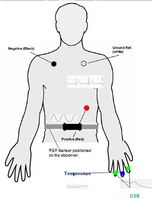Affect detection while driving, a simulation study
To understand and better intervene with drivers’ behavior, we set and conducted an experiment collecting physiological measures while drivers were dealing with different types of hazards in a driving simulator. We recorded Electro dermal Activity (EDA), heart rate variability (HRV), respiration, skin temperature and muscle tension Electromyography (EMG). Early findings suggest that early signature in the physiological signal can predict hazards and the outcome. Once quantified, a system of intervention could be introduced for different goals in mind.

Measuring heart rate, respiration, muscle tension, and GSR for affect assessment during simulated driving
Physiological measures:
EDA (Electrodermal Activity ) or GSR(Galvanic skin response)
HR (Heart rate variability, …)
Respiration
Skin temperature
EMG (Electromyography)
Physiological measures:
EDA (Electrodermal Activity ) or GSR(Galvanic skin response)
HR (Heart rate variability, …)
Respiration
Skin temperature
EMG (Electromyography)

